|
|
Solid State Gas Sensors
Products and Services
Synkera's products are based on nano- and
microstructured materials and advanced methods for their
integration into functional devices. We offer three
main product groups:
The
first is a broad group of chemical sensors
and related devices. Synkera's sensor
technology is bridging the gap between the low
cost of traditional solid-state sensors and
the performance of liquid electrolyte
electrochemical sensors.
The
second product group is comprised of membranes
for filtration and separation in gases and liquids and
related applications. Our membranes are based on self-organized
nanoporous ceramic that supports highly controllable
nanoscale morphology and composition, enabling high
performance, reliable and cost-effective solutions in a
diverse range of applications.
The
third product group includes a broad range of NanoCeramic-based
offerings with performance and benefits engineered at
the nano/microscale. These include nanotemplates,
substrates for bioanalysis, ceramic microcomponents,
functional coatings and nanocomposites.
Electronic Modules
Synkera now provides two
types of modules for testing and evaluation of our
various sensor product lines:
Our latest
MikroKera™ Ultra Module (P/N 9100) features
all-digital input and output, and even wireless
connection by Bluetooth. This module can be used for
quick and easy setup and evaluation of our UltraKera™
sensor product line (module purchase includes 1 sensor).
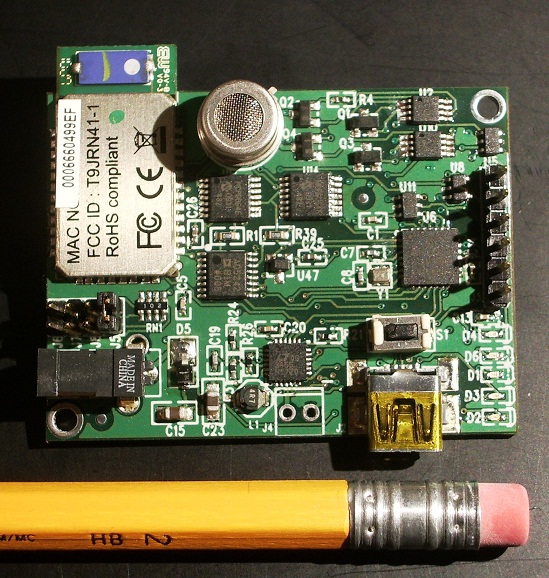 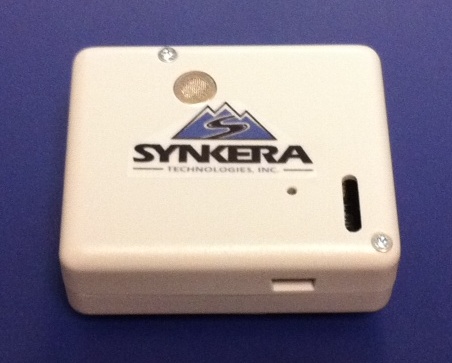
Our original set of electronic modules, encompassing P/N
901 to 917, feature analog input and output, and can be
used to operate both our
ProKera™ and
MikroKera™ sensors. These modules require a 9-12
VDC input and provide a 0-5 VDC output. These modules
allow for adjusting the input voltage to the heater,
zeroing the sensor, and setting gain. To place an order
for analog modules, visit our
online store.
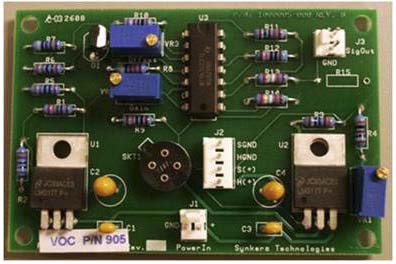
UniKera Ceramic Membranes
 Standard
Ceramic Membranes Standard
Ceramic Membranes
 Synkera's
largest 11" x 18" AAO membrane with aluminum rim. Synkera's
largest 11" x 18" AAO membrane with aluminum rim.
Synkera offers three different types of membranes:
UniKera™ Standard,
UniKera™ UF and
nanocomposite. Unique features and
performance of these products are derived from the
controllable nanoscale morphology and composition of the
active layer(s), as well as chemical and mechanical
properties of anodic
aluminum oxide. These membranes are produced using
our unique capabilities in extremely high precision
nanoscale engineering of materials architecture and
composition, following strict quality-control
procedures.
Synkera offers a range of standard products, as well as
many custom options for each membrane type. Please
follow the links below for further details or go
directly to the quote/info
forms to request a quote or to place an order.
Our
symmetric membranes feature uniform and aligned
cylindrical nanopores, ensuring consistent pore
diameter and pore density throughout the thickness of
the membrane.
Our
monolithic asymmetric membranes feature a
support layer with large pores and a
very thin (sub-0.5 µm) active layer with pores
tunable in the 5-200 nm range. This allows for precise
size-based separation, while maintaining high permeance
and low fouling. These features enable significant
performance benefits in liquid separation, such as
microfiltration, ultrafiltration and nanofiltration.
Our
nanocomposite membranes feature very thin
nanocomposite active layers intimately embedded
within the pores of anodic alumina to enable high
permeance and selectivity to target molecules and
outstanding reliability in operating conditions.
UniKera Standard Membranes
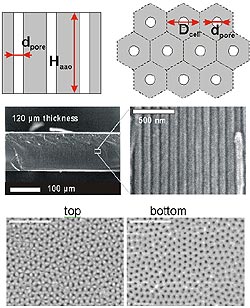
Pricing
Synkera offers symmetric monodisperse nanoporous ceramic
membranes that are produced from nanoporous anodic
aluminum oxide (AAO). This type of membrane features
a symmetrical nanoporous architecture with uniform
cylindrical pores penetrating the entire thickness of
the membrane, and are characterized by a high degree of
pore ordering and narrow pore size distribution
(standard deviation is typically better than 8%, and in
some cases is as low as 5%).
Synkera's symmetric membranes have superior mechanical
and thermal stability far exceeding that of anodic
alumina membranes from other suppliers. As-prepared AAO
membranes are amorphous, but could be converted to
nanocrystalline gamma and alpha-alumina phases which
further enhances the membrane's chemical and thermal
stability. Synkera offers several membrane
heat-treatment options for operating temperatures up to
1000°C.
The range of currently available membrane specifications
is summarized in the table below. We maintain an
inventory of membranes with standard specifications.
Most of our ceramic membranes could be ordered with a
pore diameter in the range from 10 to 150 nm, and the
thickness from 15 to 100 microns. For more details on
this product, please see the AAO
Technology Profile.
To order membranes, inquire on the product availability
for non-standard specifications, and/or get feedback on
your desired applications, please fill out our Info/Quote
Request Form.
|
Parameter |
Standard |
Custom |
|
Pore Diameter,
nm (SD 7-10%) |
18 |
35 |
55 |
80 |
100 |
150 |
10-200 |
|
Pore Density,§
cm-2 |
6·1010 |
1·1010 |
6·109 |
2·109 § |
2·109,§
9·108 |
2·109,§
9·108 |
2·1011 - 9·108 |
|
Pore Period,§ nm |
44 |
94 |
143 |
243 § |
243,§
367 |
243,§
367 |
20 - 367 |
|
Estimated Porosity,§
% |
15 |
13 |
13 |
10 § |
15,§
7 |
35,§
15 |
10% to 50% |
|
Thickness,
µm (± 2%) |
50 and 100* |
15-150 ± 2% |
|
Format / Size |
round shape: 13, 25,
47 mm
square shape: 10x10 mm |
custom shapes, up to 120 mm in
size |
|
Operating Temperature |
No heat treatment:
· up to 500°C (depending on the environment)
Heat
treatment options:
· OPTION 1: ≤ 700°C (amorphous)
· OPTION 2: ≤ 900°C (γ-alumina)
· OPTION 3: ≤ 1000°C (γ/ α - alumina) * |
up to 1000°C
(γ/ α - alumina) * |
|
Availability |
4-6 weeks if not in-stock |
Varies |
§ Standard pore density, period and porosity values
for 80, 100 and 150 nm pore sizes.
* Heat treatment option 3 is not available for 13 and
18 nm pores
Based
on our expertise in materials science, nano- and
microfabrication, and using this featured AAO membrane
as a platform, Synkera is developing a portfolio of
symmetric membrane products for the following
applications:
UniKera UF Membranes
 Asymmetric
Membranes Asymmetric
Membranes
Pricing
Synkera offers
asymmetric ceramic membranes for liquid (such as nano-
and ultrafiltration) and gas filtration, as well as for
other applications. As many of our products, these
membranes are made from monolithic nanoporous
anodic aluminum oxide (AAO)
and are characterized by very uniform pores in the
active layer. The membranes also feature a novel
architecture with a very thin and uniform active layer.
Such attributes address the need for membranes with
improved selectivity, higher permeance, reduced fouling
and better durability.
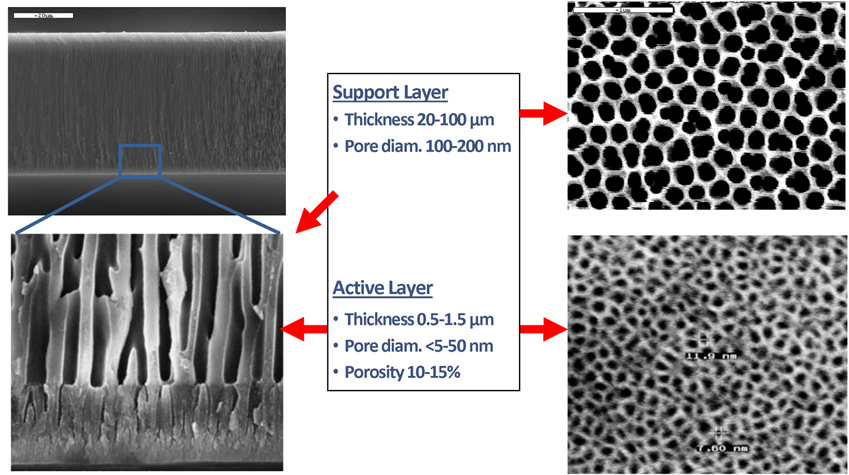 Structure
of Synkera Asymmetric Membranes Structure
of Synkera Asymmetric Membranes
Membrane
Features & Benefits
-
Narrow pore size distribution (standard deviation is
typically better than 10%) and sharp molecular
weight cutoff (MWCO)
-
Pore diameter and MWCO values are highly
reproducible
-
High pore density in a very thin active layer and
large pores and high porosity in the support layer
enable water permeance in the range of 5•10-8
cm/s/Pa
-
Smooth surface and uniform pores reduce fouling
-
Made of non-toxic and biocompatible alumina with no
extractables and no product contamination
-
Good mechanical durability and resistance to
abrasion
-
Immune to organic solvents and radiation
-
Reliable compression sealing using an optional
aluminum rim
-
Planar membranes available in a variety of standard
and custom sizes and shapes. Scalable up to 1 sq.
ft.
As-prepared membranes contain amorphous boehmite phase,
which is suitable for short (<3 hrs) exposure to aqueous
solutions. Polycrystalline membranes, composed from
gamma and alpha-alumina phases with significantly
enhanced chemical and thermal stability, are also
available. For additional information, please see Technology
Profile for this product.
Ordering
The range of currently offered membrane specifications
is summarized in the table below. We maintain an
inventory of membranes with standard specifications. To
order membranes, inquire on the product availability for
non-standard specifications, and/or get feedback on your
desired applications, please fill out our Info/Quote
Request Form.
|
Parameter |
Standard
|
Custom |
|
Base
Layer |
Pore diameter,
nm (SD 7-10%) |
150 - 200 |
same as standard
|
|
Pore density, cm2 |
1x109 |
|
Porosity, % |
30 - 40 |
|
Active
Layer |
Pore diameter,
nm (SD 7-10%) |
2 - 4 |
4 - 6 |
8 |
13 |
18 |
150 |
2-20 |
|
Pore density, cm2 |
7x1012 |
2x1012 |
3x1011 |
1x1011 |
5x1010 |
1x109 |
2x1011
to 7x1012 |
|
Porosity, % |
10 to 20,
depending on port diameter |
up to 50 |
|
Overall
Structure |
Thickness, µm
(±2%) |
50 |
|
|
Format / Size |
round shape: 13, 25 mm |
custom shapes, up
to 120mm in
size |
|
Operating Environment |
AS IS:
aqueous: short exposure (≤3hr.), pH 6 to 8
non-aqueous:
indefinite for non-corrosive
gases: up to
500°C for non-corrosive
HEAT TREATED:
≤700°C (amorphous), Option 1
≤900°C
(γ-alumina), Option 2
≤1000°C
(γ/α alumina), Option 3 |
contact us if you
have any questions on your application
|
|
Availability |
2
-3 weeks if not in stock |
Nanocomposite Membranes
Energy-efficient hydrogen generation and purification is
needed for many clean energy applications and industrial
processes. Synkera is developing novel metal/ceramic
hydrogen separation membranes that target breakthrough
performance and reliability in a broad range of
operating conditions and offer significant cost savings
at the system level. These benefits, enabled by
patent-pending nanoengineered membrane composition and
architecture, provide significant competitive advantages
for many point-of-use hydrogen separation and
purification applications. Synkera is commercializing
its hydrogen-related products, including hydrogen
separation membranes and hydrogen sensors, via its
subsidiary HyGenera
LLC.
The
key membrane features and related user benefits are
-
Nanocomposite
metal/ceramic active layer with permeance exceeding
that of 10 µm thick Pd alloy foil membranes.
-
Low defect density,
high permselectivity.
-
Mechanical
reliability, resistance to abrasion.
-
Excellent
resistance to temperature and pressure cycling,
immune to embrittlement.
-
Planar membranes of
flexible size and format.
-
Al rim to support
reliable and low-cost compression sealing.
-
Significant
reduction in the cost of membrane modules and
separation systems in comparison with Pd foils or
supported films.
Download Technology
Profile for more information on hydrogen separation
membranes.
 Hydrogen
flux vs. differential pressure for 1" laboratory
prototype. Hydrogen
flux vs. differential pressure for 1" laboratory
prototype.
Status
To
date, hydrogen permeance of up to 1.5 mmol/m2/s/Pa0.5
at 400 °C and selectivity up to 3000 were demonstrated
in laboratory prototypes. Membranes sustain repeated
temperature (75 to 450°C) and pressure (0 to 100 psig)
cycling in 100% hydrogen without loss of performance.
With support from NSF SBIR program, Synkera is scaling
Gen-1 membranes (~1 mmol/m2/s/Pa0.5)
to produce prototypes sized at 30 cm2 and 725
cm2. Concurrently, we are validating membrane
performance and reliability in select process streams (reformate
and WGS).
 Temperature
cycling performance of Synkera membrane (100% H2,
60 psig). Temperature
cycling performance of Synkera membrane (100% H2,
60 psig).
Partnership Development
Customers and partners are being sought for evaluating
these membranes in new membrane systems and
applications. Areas of interest include fuel cells,
point-of-use and distributed purification, as well as
industrial processes. To request additional information
and to discuss this further, please e-mail us at
UniKera Membranes

Our UniKera™ line of ceramic disc membranes are used
for:
Our membranes feature configurable specifications in
a wide range of options:
|
Parameter |
Range |
|
Pore Diameter,
nm (SD 7-10%) |
10-200 |
|
Thickness,
µm (± 2%) |
15-150 |
|
Format / Size |
Round, square, custom. Up to 120 mm in
size |
|
Operating Temperature |
up to 1000°C |
|
Availability |
4-6 weeks, depending on stock |
Descriptions and specifications of our two membrane
types are provided below. In addition, follow these
links for further info:

UniKera™ Standard Membranes
Synkera offers ceramic
membranes that feature uniform cylindrical pores
penetrating the entire thickness of the membrane, and
are characterized by a high degree of pore ordering and
narrow pore size distribution. UniKera™
membranes have superior mechanical and thermal
stability far exceeding that of anodic alumina membranes
from other suppliers. UniKera™ membranes can be
converted into nanocrystalline gamma and alpha-alumina
phases, to further enhane chemical and thermal
stability. Synkera offers several membrane
heat-treatment options for operating temperatures up to
1000°C.
UniKera™ UF Membranes
These membranes feature a novel architecture with a very
thin and uniform active layer, and are characterized by
very uniform pores in the active layer. UniKera™
UF membranes address the need for membranes with
improved selectivity, higher permeance, reduced fouling
and better durability.
 Structure
of Synkera Asymmetric Membranes Structure
of Synkera Asymmetric Membranes
NanoCeramics
 Anodic
Alumina Nanotemplate Anodic
Alumina Nanotemplate
 Micromachined
Ceramic Micromachined
Ceramic
Synkera offers several product lines based on our nano/microfabrication
technologies. Unique features and performance of
these products are derived from precisely controlled
nanoscale morphology, composition chemical and
mechanical properties of anodic
aluminum oxide, our unique processes for ceramic
micromachining and ability to conformally coat very high
aspect ratio nanopores with different materials.
Synkera offers a selection of standard products, and
also welcomes inquiries for custom manufacturing. Please
follow the links below for further details.
Synkera offers a broad range of anodic
alumina-based nanotemplates of three distinct
formats: AAO on Al foil, AAO integrated on Si, glass or
other substrates, and free-standing AAO. These products
feature excellent pore diameter uniformity and have been
used by a number of research groups worldwide for
deposition of uniform and ordered arrays of
nanostructures (nanoparticles, nanowires, nanorods,
nanotubes, etc) as well as for synthesis of advanced
nanocomposites.
Synkera offers custom ceramic microcomponents
from nanoporous alumina that can accommodate
diverse application ranging from high temperature gas
sensing to in-vivo bioanalysis. Our
process combines features of both surface- and bulk–
like micromachining and can support a broad range of
designs, including high-resolution, high aspect ratio
structures and elements of 3-D designs.
We
offer nanoporous ceramic substrates for various
life science applications. The substrates
feature excellent biocompatibility, 3-D nanoporous
architecture and are available in several formats to
support a variety of analysis modes.
Conformal nano-scale coatings on high aspect
ratio surfaces are available for all of our AAO-based
membrane and nanotemplate products as well as on
customer-provided samples.
UniKera NanoTemplates
Synkera offers a broad range of anodic alumina-based
nanotemplates of three distinctly different
architectures:
-
AAO Nanotemplates attached to Al foil (see
specifications below).
-
Free-standing AAO nanotemplates (specifications same
as UniKera™
standard membranes).
-
Nanotemplates on non-Al substrates, such as Si or
glass (
email us
This email address is
being protected from spambots. You need JavaScript
enabled to view it.
for availability).
Most of our AAO nanotemplates and nanoporous
membranes could be ordered with pore diameter in 10-100
nm range. They are characterized high degree or pore
ordering, narrow pore size distribution (standard
deviation is typically better then 10%, and in some
cases as low as 5%), as well as uniform pore diameter
across the entire AAO thickness. For free-standing
nanotemplates, standard heat-treatment options include
annealing of the originally amorphous AAO to
nanocrystalline gamma or alpha-alumina phase, which
further enhances nanotemplate's chemical and thermal
stability.
The range of currently available specifications for
nanotemplates on Al and other substrates is summarized
in the table; specifications for free-standing AAO
nanotemplates are listed under
UniKera™ standard membranes.
To order nanotemplates, inquire on the availability of
custom products with non-standard specifications, and to
discuss your specific applications, please fill out our Info/Quote
Request Form.
|
Parameter |
AAO on Al * |
AAO on
non-Al substrates**
(custom only) |
|
Standard |
Custom |
|
Pore diameter,
nm (SD 7-10%) |
13 |
18 |
35 |
55 |
73 |
80 |
100 |
150 |
10 - 200 |
10 - 35 |
|
Pore Density,§
cm-2 |
1·1011 |
6·1010 |
1·1010 |
6·109 |
3·109 |
3·109,
2·109 §
|
3·109,
2·109,§
9·108 |
2·109,§
9·108 |
2·1011 - 9·108 |
1·1011 - 1·1010 |
|
Pore Period,§ nm |
32 |
44 |
94 |
143 |
193 |
193, 243 §
|
193,
243,§
367 |
243,§
367 |
20 - 367 |
20 - 107 |
|
Estimated
Porosity,§ % |
15 |
15 |
13 |
13 |
13 |
16,
10 §
|
24,
15,§
7 |
35,§
15 |
10 - 30 % |
10 - 30 % |
|
AAO Thickness,
µm (± 2%)
|
0.5, 5 and 50
|
5 and
50 |
0.1 - 150 |
0.1 - 5,
per Al film thickness |
|
Format / Size * |
square shape; 10x10 mm and 65x65
mm;
AAO on one or both sides of Al substrate * |
from 65x65 mm to 150 mm *‡ |
per customer substrate size and format
(up to 150 mm)
|
|
Operating Temperature |
No heat
treatment: up to 500°C
(depending on the environment)
Heat treatment option 1:
500°C
|
N / A |
|
Availability
|
3-4 weeks if not in-stock |
4-6 weeks |
4-6 weeks |
* AAO on one side of
the Al substrates is only available for thicknesses 0.5
and 5 µm.
** Requires Al films on Si, glass or other substrates to
be provided by the customer; e-mail for requirements.
§ Standard pore density, period and
porosity values for 80, 100 and 150 nm pore sizes
‡ Custom AAO on Al nanotemplates can be cut into smaller
size pieces per customer requirements
Some of the applications for the featured
nanotemplates and nanomembranes include:
Ceramic Microcomponents
 Micromachined
ceramic Micromachined
ceramic
Demand for robust and resilient microcomponents
increases with the continuous trend towards
miniaturization. Many existing and new applications
require microcomponents from refractory materials to
obtain requires mechanical properties and ensure
stability in harsh environments. Although silicon
carbide, silicon nitride, and sapphire have been
identified as candidates for this type of MEMS,
combination of high cost, poor manufacturability, and
very limited designs stimulates the development of new
technologies.
Synkera Technologies addresses these needs using its ceramic
micromachining technology to produce microcomponents
from nanoporous alumina with the following features:
-
Chemically &
thermally robust ceramic microstructures
-
Multilevel,
surface- and bulk-like micromachining
-
High aspect ratio
(1:100); high resolution (2-3 µm)
This
technology enables very flexible designs and provides
numerous opportunities for development of novel ceramic
microcomponents and microdevices:
Substrates for Bioanalysis & Bioarrays
Bioarrays enable high-throughput molecular analyses and
have aided tremendous advances in life science research.
Further increasing bioarray sensitivity and
reproducibility will enable broader acceptance and
standardization for more demanding settings, such as
clinical diagnostics. Furthermore, increasing the range
of options in bioarray substrates and surface
chemistries - key elements in performance - will enable
greater design flexibility and novel applications,
especially with respect to protein and glycan-based
arrays.

Synkera is developing novel bioarray and bioanalysis
substrates that can significantly enhance bioarray
performance through a unique 3-D nanoporous architecture
that features high specific surface area and flexible
surface chemistry. These substrates can serve as drop-in
replacement for current glass-based arrays as well as
support novel bioarrays and assays.
Substrate features and
benefits
-
High probe capacity
due to high surface area, 3-D architecture of
nanoporous ceramic substrate.
-
Ability to vary the
capacity via control of the pore depth.
-
Ability to block
large molecules interference based on size
exclusion.
-
High-resolution
spotting due to wicking into vertically aligned
pores, eliminating lateral spreading.
-
Tailorable surface
chemistry for various attachment options and
minimized non-specific background binding.
-
Optional
flow-through architecture for increased sampling
rate and fast analysis of low concentration targets.
-
Micromachinable for
integration with advanced microfluidics
(lab-on-a-chip).
Status
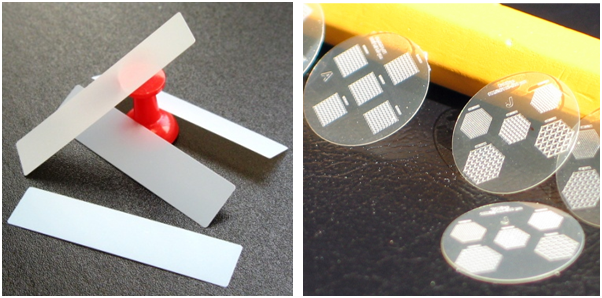 Left:
8 mm x 35 mm array substrates with 150 nm pores.
Right: representative microchips for bioanalysis Left:
8 mm x 35 mm array substrates with 150 nm pores.
Right: representative microchips for bioanalysis
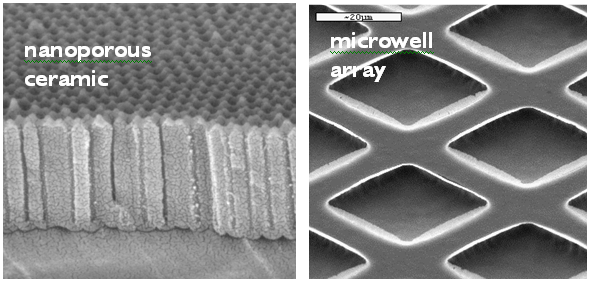 Left:
SEM of ceramic array substrate with 50 nm pores.
Right: array of microwells in nanoporous ceramic
substrate. Left:
SEM of ceramic array substrate with 50 nm pores.
Right: array of microwells in nanoporous ceramic
substrate.
Leveraging its extensive capabilities in developing
numerous products based on this
material platform, Synkera completed initial
development of Gen-1 bioarray substrates. Prototypes are
being evaluated for fluorescence-based assays and other
bioanalysis applications. You can see our current
offerings and get further info by filling out an Info/Quote
Request form.
Partnership Development
|





 Synkera's
largest 11" x 18" AAO membrane with aluminum rim.
Synkera's
largest 11" x 18" AAO membrane with aluminum rim.
 Asymmetric
Membranes
Asymmetric
Membranes Structure
of Synkera Asymmetric Membranes
Structure
of Synkera Asymmetric Membranes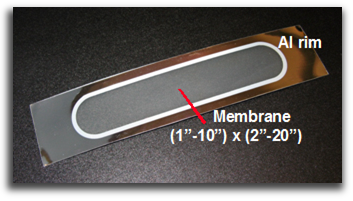
 Hydrogen
flux vs. differential pressure for 1" laboratory
prototype.
Hydrogen
flux vs. differential pressure for 1" laboratory
prototype. Temperature
cycling performance of Synkera membrane (100% H2,
60 psig).
Temperature
cycling performance of Synkera membrane (100% H2,
60 psig). Structure
of Synkera Asymmetric Membranes
Structure
of Synkera Asymmetric Membranes Anodic
Alumina Nanotemplate
Anodic
Alumina Nanotemplate

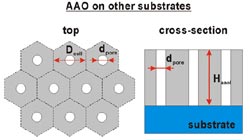

 Left:
8 mm x 35 mm array substrates with 150 nm pores.
Right: representative microchips for bioanalysis
Left:
8 mm x 35 mm array substrates with 150 nm pores.
Right: representative microchips for bioanalysis Left:
SEM of ceramic array substrate with 50 nm pores.
Right: array of microwells in nanoporous ceramic
substrate.
Left:
SEM of ceramic array substrate with 50 nm pores.
Right: array of microwells in nanoporous ceramic
substrate.